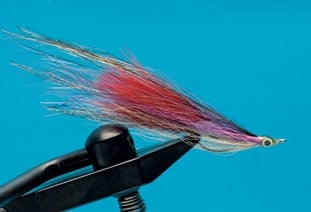
Fly-fishing for false albacore from rocky structure can be tough. Their remarkable visual acuity, combined with ever-present obstacles such as lobster pots and pilings, demand a crafty fly. This is especially true at high tide when eel grass floats in, which so often is the most productive time.
Each fall, these game fish pursue anchovies from New England to New Jersey. Silversides also mix in, and the albacore will target these two baits exclusively even when other forage is present.
Over the years, I frequently saw albacore mingling with bait and eel grass at high tide. But I became flustered with flies picking up debris. I sought a pattern less likely to pick up weeds, and I also needed something different that would truly stand out in these adverse conditions.
I wanted a fly that displayed a mortal wound in the mid-body to tail area, as if incapacitated during a blitz. The challenge was not necessarily to simulate a reddish wound below the body, but to blend it halfway through the pattern to the tail in a weed-resistant format, replicating wounds on a blitzed baitfish.
An obvious solution was to tie a small bendback, which would slip through the weeds and imitate both baitfish. For the bleeding factor, I knew red marabou would be ideal – it would serve as the Bleeding Bendback Anchovy’s trigger.
I used a radical approach, tying the marabou in the hook bend behind the barb. I knew the fluffy marabou would not impede the hookset, but the thread had to be unobtrusive, lying well below a crushed barb. I used very few wraps of 6/0 thread and Hard-as-Hull cement to secure the red trigger. The end result was no more of a hookset detriment – perhaps even less – than a monofilament weed guard tied halfway up the hook shank.
Next up was a field test. It tracked flawlessly, hook point up with no fouling. The red marabou fluttered like a Tim Wakefield knuckle ball! The bucktail, marabou and Angel Hair give this fly fluidity, and the pearl braid emanates a green/pearl sheen. A sprinkling of rainbow Angel Hair in the lateral line mimics a flashing anchovy.
The Bleeding Bendback Anchovy is an adaptable, snag-resistant design that excels when false albacore chase their favorite baits: anchovies and silversides.
Next Page: Tying Instructions >>
Materials
HOOK: 1/0 or #1 Gamakatsu SS15
THREAD: Tan and red Danville’s 6/0
UNDERBELLY: Tan bucktail
LATERAL LINE: Angel Hair rainbow
OVERWING: Pink and lavender bucktail and brown/black Angel Hair
BODY: Gudebrod pearl metallic
TRIGGER: Red marabou
EYES: White/black painted or small prismatic stick-on
CEMENT: Hard-as-Hull
| Step 1: Bend hook eye downward slightly with pliers until the metal just bends. Then anchor in vise, tie in a length of braid at the bend and wrap to hook eye. Secure with a half hitch. |
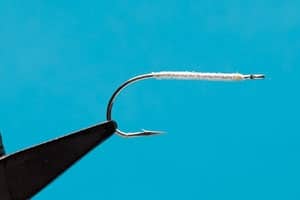
| | Step 2: Make four level wraps of red thread 116-inch behind the hook barb. Wet the end of a small tuft of red marabou so it’s fully compressed. Tie it to the top side of the hook to the bend with a few more wraps. Carefully whip finish with two wraps, and apply a dab of Hard-as-Hull cement.|
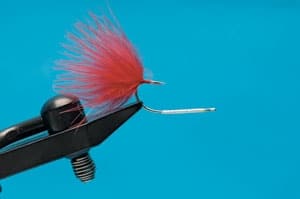
| | Step 3: Select some fine, tan bucktail about 3 inches long. Preen out rougher, shorter strands. Tie in just behind the hook eye, then tie in a bunch of rainbow Angel Hair. The flash should extend slightly beyond the bucktail. This material will push the red marabou down – pull it up through the bucktail and flash.|
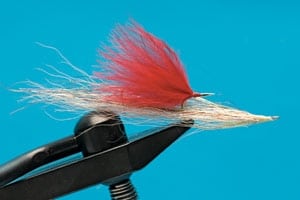
| | Step 4: Complete the wing by tying 3-inch lengths of pink and lavender bucktail above the Angel Hair, then a topping of brown/black Angel Hair (again, slightly longer than the bucktail). Taper thread to form a head large enough for painted or stick-on eyes.|
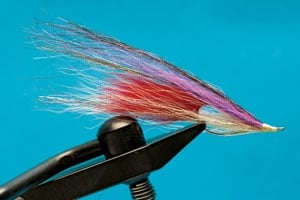
| | Step 5: Appy two coats of Hard-as-Hull, then paint or apply stick-on eyes and a final coat of cement.|
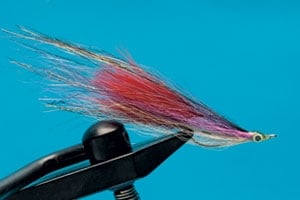
|









